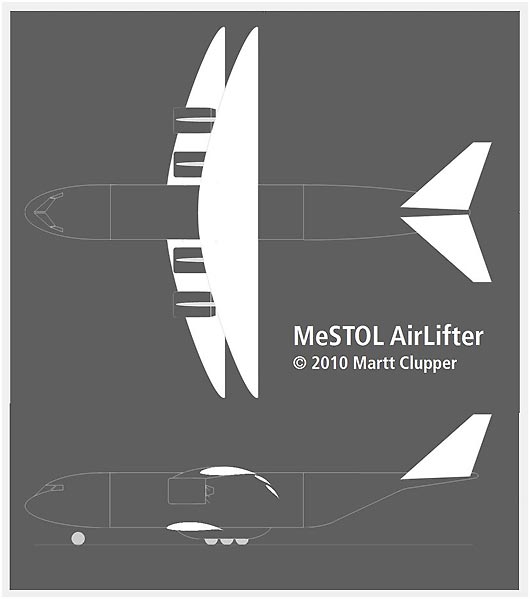Yep, I Think The USAF Needs A Negative Stagger V-Tail Bipe!
 Wednesday, November 3, 2010 at 10:14PM
Wednesday, November 3, 2010 at 10:14PM  My concept for a Medium extreme STOL (MeSTOL) Airlifter - (c) 2010 Martt Clupper
My concept for a Medium extreme STOL (MeSTOL) Airlifter - (c) 2010 Martt Clupper
I admit that I'm a frustrated aeronautical engineer wannabe. I wound up passing on my acceptance to Purdue in engineering for the fall of 1979 and decided to become an airport bum instead. The allure of a small country airport with a 'clip-wing Cub' to play with and lots of grass to mow was too much of an opportunity to pass up. But that doesn't mean that the guy who wanted to design great airplanes isn't around anymore. He's still right here inside my head... and sometimes he yells loud enough that we can all see what he's thinking : )
This design is what I call the MeSTOL Airlifter, or Medium extreme STOL Airlifter. It picks up where the Advanced Medium STOL Transport concept from the mid 70's left off. The AMST role was intended to be a replacement for the C-130, but with more lifting capability and even shorter takeoff and landing performance. The YC-14 and the YC-15 were both excellent aircraft, but the AMST idea was abandoned, interestingly enough, in 1979. Now we're many years down range, and yet the C-130 is still the workhorse of the smaller side of airlifting. There's a rapidly growing need tho for a replacement that offers greater flexibility and increased capability. It would also be far cheaper to acquire and operate than the much larger C-17.
I plan to provide more details later, but the basic idea with the MeSTOL is that it's a little bigger all the way around than the C-130J, the largest and most recent variant of the C-130, but it's smaller than the Airbus A400M. The MeSTOL has several very unique features, including:
* Negative stagger biplane wing configuration
* Non-circular (slab side) cross section to maximize interior volume
* Composite wing, aluminum fuselage
* 4 geared turbofan engines (PW1400G - approx 26,000 pounds of thrust each)
* Direct thrust blown flaps on the upper wing (similar to the C-17 flaps)
* Vectored thrust vanes on the engines to provide direct lift enhancement
* Vectored thrust also works to increase operational AOA on the lower wing
* V-Tail
As always, I'd be interested in your feedback, even if you think I'm crazy. Even better, it would be awesome if some other frustrated aero engineer wannabes like me would throw together a unique concept for the MeSTOL role. Here are the basic design goals: minimum cargo bay width is 13 feet, cargo load requirement is 80,000 pounds, and minimum runway performance of 2,500 feet with 50,000 pound cargo on board.
Would my concept for the MeSTOL achieve these goals? I dunno, I'm just making this stuff up! But I honestly do believe there are some interesting and viable ideas presented here, and I always enjoy the challenge of thinking outside the bun : )
disclaimer: I've got about 4 hours total time in this project which includes the aerodynamic concepts, the actual design, and making the drawings. It's not intended to all make sense... it's just meant to be a strong starting point for continued thought.
 Martt |
Martt |  11 Comments |
11 Comments | 













































































Reader Comments (11)
Hi Martt,
Good brain food. I was thinking about the engine placement. Although the vectoring of thrust with the flaps will improve take off performance, the high speed flow under the top wing would tend to decrease pressure, and therefor, lift. If the engines were moved back, under the top wing, you eliminate the jet flow under the top wing, and put the intakes over the bottom wing, thus reducing the pressure there. I wonder how much lift that would add. What do you think?
Scott- Thanx for your thoughts. If you look at the C-17 engine placement, you'll see that they are actually a little farther forward, and they've really enhanced the overall lift by using engine thrust re-directed by the large flaps. Plus, you might not really see what unique feature I have in mind for the air coming out of the engine nacelles (I've intentionally not gotten very specific about this yet)... there are vanes that are designed to re-direct about 75% of the air coming off the large fan up front. The way I have it drawn now, about 25% of the fan air, and all of the high speed air out the tailpipe are directed at the top wing flaps, but 75% of the fan air is thrust-vectored by the vanes downward. This does two specific things: 1) creates a direct lift component 2) and this large amount of air moving downward past the trailing edge of the lower wing pulls the air going over the top of the lower wing with it, in theory allowing that wing to operate at a higher angle of attack (this might be a flawed theory).
The engines have been positioned in such a way that the vectored thrust from the vanes is very close to the effective center of pressure of the wings, hopefully reducing the pitching from the vectored thrust. I also have some theories about cool things that might be happening with the lower wing from having the engines sucking in massive amounts of air when in STOL mode (high power settings) but those ideas are a little dreamy. The ultimate goal here is to combine two wings, the massive intake airflow of the engines, and the re-directed outflow from the engines to create far more lift than we've seen in "normal" configurations from the past. Obviously, loads of actual testing are needed to verify most of my ideas, but I think they have some interesting merit.
BTW, I'm glad you see this little exercise as brain food (which is why I posted it all to begin with : )
Martt,
Fan flow over the bottom wing sounds like a good idea. By the way, what is the advantage of the V tail?
Scott
Scott- I think the V-Tail helps reduce parts count (helps in both engineering and manufacture) as well as the total installed weight. With sophisticated flight control computers, it should be relatively easy to make the V provide excellent performance while still being minimalistic.
One of the other primary goals for this design is to reduce the cost of design, engineering, manufacture and operation. That's not to say that this airplane is extremely simple, just that compared to the trends we've been seeing in aerospace, this is intended to be more cost effective at every turn.
I like the V-tail. Why not put an engine or two on top of the wide body. That way you can remove two engines from the outboard stations.With vectoring thrust and clam shell reversers, you also get clean air to the engines. Just my 2 cents.
I like the V-tail. Why not put an engine or two on top of the wide body. That way you can remove two engines from the outboard stations.With vectoring thrust and clam shell reversers, you also get clean air to the engines. Just my 2 cents.
Nice job! I have a rather similar requirement for one of my own designs. Like you, I'm not an aeronautical idea, I design aircraft due to my love for them!
One of my earlier designs was quite similar to yours, with a biplane layout. However, from what I know, interactions between the airflows around the wings in a conventional biplane reduces their efficiency, meaning you get barely a 15% increase from the other wing.
I would suggest these for your aircraft. My design uses a tandem wing layout. Moved the lower wing to the front of the aircraft, and the top wing to the rear. The lower wing is placed in the front to reduce downwash interaction between them. This in combination with upper-surface blowing on the rear wing can allow for an increased amount of lift. I might consider blown flaps for the front wing, since my target is a 50-passenger jet with a takeoff speed of around 60 knots. You can use a simple horizontal stabilizer since either of the wings can be used for pitch control. Another change I would suggest is the wing shape. Make more conventional, with a relatively low amount of sweep, a supercritical airfoil section can reduce drag for high cruise speeds.
Anyways, I love the ideas in your design, keep it up!
No cross wind landings for this plane!
Interesting idea! Remember the QSRA?
Well, why not increase the negative stagger, put two engines on the top and two engines on the bottom wing so they blow on top of both wings QSRA style. Since you have four engines, add the air cushion landing system they were messing with back in the day. (cheap to build, lighter than a wheeled gear, lands easily in crosswinds AND can land on any surface, water, sand, snow, grass etc.) make both port upper and lower wings identical and do the same for the starboard ones, and of course use identically made v-tails so they can be interchangeable. Give it a circular fuselage cross section, (easy to stretch) plumb it for JATO, and make it autonomous and you'll have our future medium lift battlefield tactical
transport!
that would be cool to see
Hi,
I spent my 20th year around C-47s and C-130A to H. Educational experience!
A HondaJet front wing (including the engines, flaps, giving us two sets of front wheels, by modifying the HondaJet's main wheels, and so on), and similar, but bigger, rear wing, similar to the HondaJet's, but bigger, and a T-tail, to take care of deep-stall tendencies, not that unknown for canards.
Pressure cabin is much liked by passengers, crew, and dampens internal noise as well!
Same engines, front and rear wing, no risk of debris ingestion with the engines on top of the wings, and no nosewheel in front of the front wing to throw up much on the runway! Possibly a small stub wing at CG to stow the main gear in?!